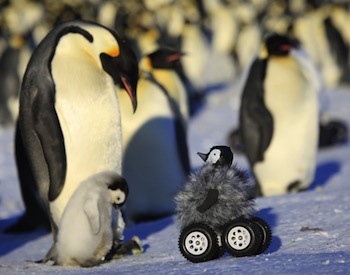
A new study shows that a robotic rover disguised to look like a penguin can get close to animals without raising their stress response as much as a human would. Such rovers could be used to read electronic tags implanted in wild animals. (Photo credit: Le Maho, et. al)
A robotic rover disguised to look like a penguin has shown promise in helping to track animal movements.
In some fields, such as fish farming, animals are implanted with passive integrated transponder (PIT-tags), a kind of electronic barcode that can be read by a hand-held device at a distance of up to 2 feet. However, wild animals can be stressed when humans approach that close.
The new study shows that the stress response (measured by heart rate) when a robotic rover approached a penguin is less than when a human approaches, and the rover causes less disorganization of the colony. The less invasive method could also be used to approach other animals that are wary of humans, such as southern elephant seals.
Original research paper published in the Journal of Sexual Medicine on November 2, 2014.
Names and affiliations of selected authors



